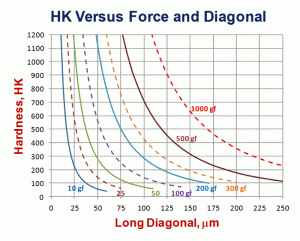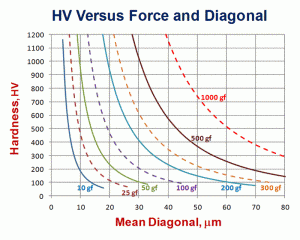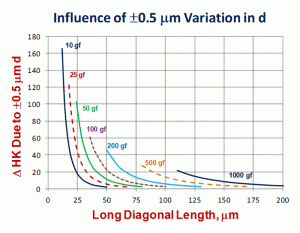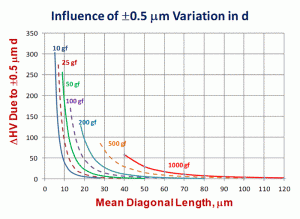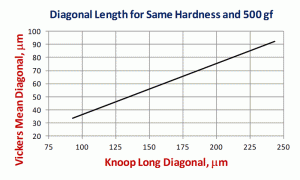The basic equations defining (see equations 1 and 2) the Knoop (HK) and Vickers (HV) hardness, where the applied force is multiplied by a geometric constant and then divided by the long diagonal squared or the mean diagonal squared, respectively, cause an inherent problem in measuring small indents, that is diagonals ≤20 µm in length. Figure 1 shows the calculated relationship between the diagonal and load and the resulting hardness for Knoop indents while Figure 2 shows this relationship for Vickers indents. As the test load decreases, and the hardness rises, the slope of the curves for diagonal versus hardness becomes nearly vertical. Hence, in this region, small variations in diagonal measurements will result in large hardness variations.
HK = 14229 L/d2 (1)
HV = 1854.4 L/d2 (2)
If we assume that the repeatability of the diagonal measurement by the average user is about ±0.5 µm, which is quite reasonable, and we add and subtract this value from the long diagonal length or the mean diagonal length, we can then calculate two hardness values. The difference between these values is ΔHK and ΔHV, shown in Figures 3 and 4. From these two figures, we can see how the steepness of the slopes shown in Figures 1 and 2 will affect the possible range of obtainable hardness values as a function of the diagonal length and test force for a relatively small measurement imprecision, ±0.5 µm. These figures show that the problem is greater for the Vickers indenter than for the Knoop indenter for the same diagonal length and test force. For the same specimen and the same test force, the long diagonal of the Knoop indent is 2.7 times greater than the mean of the Vickers’ diagonals, as shown in Figure 5.
George Vander Voort has a background in physical, process and mechanical metallurgy and has been performing metallographic studies for 47 years. He is a long-time member of ASTM Committee E-4 on metallography and has published extensively in metallography and failure analysis. He regularly teaches MEI courses for ASM International and is now doing webinars. He is a consultant for Struers Inc. and will be teaching courses soon for them. He can be reached at 1-847-623-7648, and through his web site: www.georgevandervoort.com
To View a listing of all George’s articles please click here
Read George Vander Voort’s Biography

